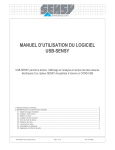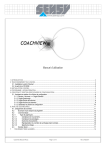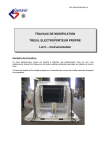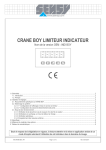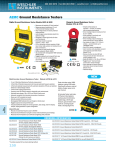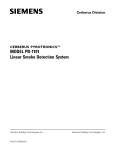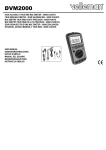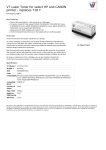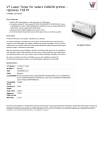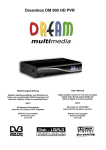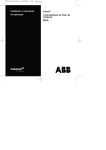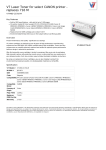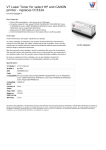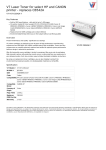Download shear-pin force transducer series 5000-5300-5600
Transcript
SHEAR-PIN FORCE TRANSDUCER SERIES 5000-5300-5600 User’s manual MA-5000-5300-5600 full_EN Page 1 of 41 Rev: 02/07/2010 1. Introduction .....................................................................................................................................................................................................3 1.1. Force measurement equipment..............................................................................................................................................................3 1.2. Hoisting equipment .................................................................................................................................................................................3 2. Operating conditions of load pin in hoisting devices .......................................................................................................................................4 2.1. Installation ..............................................................................................................................................................................................4 2.2. Operation ................................................................................................................................................................................................4 2.3. Disassembly ...........................................................................................................................................................................................9 3. Periodic inspections ........................................................................................................................................................................................9 4. Wiring ............................................................................................................................................................................................................10 4.1. Typical load cell output signal...............................................................................................................................................................10 4.2. 4-20 mA 3-wire (option J) (see §5.2) ....................................................................................................................................................10 4.3. 4-20 mA 2-wire (option C) (see §5.2) ...................................................................................................................................................10 4.4. 0-10V (1-5V) 3-wire (option T) (see §5.2).............................................................................................................................................10 5. Technical features ........................................................................................................................................................................................11 5.1. General .................................................................................................................................................................................................11 5.2. Electronic ..............................................................................................................................................................................................12 6. Options ..........................................................................................................................................................................................................13 6.1. Greasing hole .......................................................................................................................................................................................13 6.2. Helical greasing groove ........................................................................................................................................................................13 Open clevis sockets .....................................................................................................................................................................................14 6.3. Connector and cable gland options ......................................................................................................................................................14 6.4. Faradization options .............................................................................................................................................................................14 6.5. Multidirectional pin ................................................................................................................................................................................15 6.6. Load pin with external thread ...............................................................................................................................................................15 7. Theory ...........................................................................................................................................................................................................16 7.1. Basic principles: Strain gauge load cells. .............................................................................................................................................16 7.2. Mechanical dimensioning .....................................................................................................................................................................17 7.3. Sensitivity .............................................................................................................................................................................................17 7.4. Factors in signal deterioration ..............................................................................................................................................................20 7.4.1. Disturbances related to force misalignment .................................................................................................................................20 7.4.2. Disturbances related to parasitic forces .......................................................................................................................................21 7.4.3. Disturbances related to binding or wrong assembly ....................................................................................................................21 7.4.4. Disturbances related to impact or overload .................................................................................................................................21 7.4.5. Disturbances related to spurious electromagnetic signals ...........................................................................................................22 7.4.6. Electrical zero drift .......................................................................................................................................................................22 7.5. Calibration ............................................................................................................................................................................................22 8. Electronics .....................................................................................................................................................................................................23 8.1. New Bridgeboy-1R ...............................................................................................................................................................................23 8.2. New Bridgeboy-3R ...............................................................................................................................................................................23 8.3. Crane-boy .............................................................................................................................................................................................24 8.4. DISP PAX .............................................................................................................................................................................................24 9. NEW Application : load limitation and DYNAMIC WEIGHING ......................................................................................................................25 10. NEW Application : load limitation on MOBILE CRANES.............................................................................................................................26 10.1. General diagram .................................................................................................................................................................................26 10.2. Load limiter operation .........................................................................................................................................................................27 10.3. Factory-calculated charts with or without outriggers ..........................................................................................................................28 10.4. Main display ........................................................................................................................................................................................29 11. Customized electronic enclosures ..............................................................................................................................................................30 12. Recording and analysis of overhead crane OPERATION using load pins. Error evaluation ......................................................................32 12.1. Measurement system errors (load pin and electronics)......................................................................................................................32 12.1.1. Errors due to load pins ...............................................................................................................................................................32 12.1.2. Errors due to control electronics ................................................................................................................................................32 12.2. Errors due to hoisting device ..............................................................................................................................................................32 12.2.1. Errors due to the height of the cable ..........................................................................................................................................32 12.2.2. Errors due to friction in the pulley blocks ...................................................................................................................................32 12.2.3. Errors due to dynamic phenomena ............................................................................................................................................33 13. DOUBLE BRIDGE OPTION ........................................................................................................................................................................34 14. Drawings .....................................................................................................................................................................................................37 15. Warranty ......................................................................................................................................................................................................40 MA-5000-5300-5600 full_EN Page 2 of 41 Rev: 02/07/2010 1. INTRODUCTION The shear-pin force transducer consists of a cylindrical pin or shaft instrumented with strain gauges to sense shear strains caused by load. Load pins can be integrated into any mechanical systems, by simple replacement of an existing pin. SENSY designs and produces a broad range of standard and custom made load pins (Clevis pin), tailoring their dimensions to your installation. Shear-pin force transducers are designed for the following applications: - Load limitation, load indication, load recording of hoisting equipment such as overhead cranes (EOT), jib cranes, gantry cranes, container cranes, etc. - Control of strains on civil engineering structures such as suspended road bridges, boat lifts, dams, etc. - Industrial weighing on mobile and grapple cranes, steel plant cranes, silos, etc. - Force measurement on mechanical systems such as hydraulic jacks, rolling mills, steel coating machinery, test benches, etc. SENSY offers associated electronics tailored to each application. SENSY load pins are made of high-strength stainless steel and measure a wide range of loads and forces from 500 N (50 kgf) to 10 MN (1000 tf). 1.1. Force measurement equipment SENSY force measuring load pins are designed to withstand forces up to 1.5 times higher than the nominal load without any metrological damage. The mechanical design of the pins is carried out using dedicated calculation software. CAD and finite elements software are used to define and confirm the robustness of the pin designs in various environments (industrial, laboratories, harsh marine conditions, etc.) In force measurement applications, the sensitivity of SENSY load pins can reach 1.5 ... 3mV/V. 1.2. Hoisting equipment Hoisting load pins are specifically designed for fatigue and occasional static forces 2 times higher than their nominal load without any metrological and mechanical damage. Beyond twice the nominal load, the reliability of the measurements is no longer guaranteed (drift beyond 200%). The breaking load is above 5 times the nominal load. Hoisting load pins are designed to withstand severe dynamic cycles. MA-5000-5300-5600 full_EN Page 3 of 41 Rev: 02/07/2010 2. OPERATING CONDITIONS OF LOAD PIN IN HOISTING DEVICES 2.1. Installation - The delivered pin must be used in the conditions specified in the technical datasheet and according to the described conditions. - The force on the pin must be applied in the preferential direction as shown by the arrow. A variation of ± 3° is acceptable. - Verify that the force on the centre of the pin is in the direction shown by the arrow placed on the dynamometer. The data sheet provided also mentions this information. - The pin must be mounted freely in its seating (tolerance H9/h9 sufficient for load limitation; tolerances H7/h7 are better for load measurements). In the case of rotary applications, we strongly recommend mounting with bearings (tolerance h6 required optionally on load pins 5000/5600, standard on 5300), mounting with bushing may be suitable for low rotation speeds (tolerance h7 optional). In this case, the manufacturer’s specific pressure recommendations must be respected. - The pin must work only in shear. It should not normally be subject to parasitic strains such as: torsion, flexion, traction or axial compression. It is therefore necessary to decouple the forces by appropriate mounting (e.g. use of rolls, or rings of well lubricated bronze). - The pin cannot be seated by force or by applying heavy impacts. Nevertheless, you may use a wooden mallet to ensure proper adjustment. - After seating the pin, it must not have an axial clearance of more than 1° compared to its seating position. - The delivered cable must not be extended, but must be kept as short as possible. It is mandatory to connect the pin to its electronic unit according to the colour codes specified on the pin datasheet, exclusively and in compliance with the specifications of the electronic unit used. The installation technician will ensure the integrity of the cable after assembly at site. Any damage to this cable or to one of the conductors will require replacement by SENSY. - The load is uniformly distributed over at least 80% of the distance between the junction plates. Written agreement by the manufacturer is mandatory for particular service conditions. 2.2. Operation - The shear-pin force transducer is designed to withstand occasional static overload, without damage, up to 2 x the Nominal Load (case of test load for an overhead crane). In any case, a higher overload (static or dynamic) is not acceptable. - Where the bore rotates on the pin (pulley), precautions must be taken to avoid jamming of the pin: o self lubricated rings o greasing o use of a ball bearing. In case of jamming, the pin must to be returned to us for inspection. - Make sure that there is no restraint on the deformation of the pin. - The load handled must be free and compatible with the nominal load of the system: o no anchorage to the ground or support o no collision with another load or structure o no jamming MA-5000-5300-5600 full_EN Page 4 of 41 Rev: 02/07/2010 o no impact produced by another load falling on the handled load. - The pin must not be subject to impacts related to the conditions of use: case of a swinging mono-shaft colliding with the winch chassis in the swing of the pulley block. 1. 2. 3. 4. Load pin Locking plate Fastening screw Washers MA-5000-5300-5600 full_EN Page 5 of 41 Rev: 02/07/2010 Clearance (min. 0.5 mm) between thimble and supports Locking plate Load pin Thimble Lateral supports MA-5000-5300-5600 full_EN Page 6 of 41 Rev: 02/07/2010 MA-5000-5300-5600 full_EN Page 7 of 41 Rev: 02/07/2010 MA-5000-5300-5600 full_EN Page 8 of 41 Rev: 02/07/2010 2.3. Disassembly - Disconnect the connector Remove the pin from its tare (also remove it from the assembly: thimble, pulley block…). Remove the fastening screws of the locking plate. Remove the locking plate Remove the pin. Certain pins have internal extraction threads in which bolts can be placed. Protect the pin from moisture and impacts. 3. PERIODIC INSPECTIONS - Make sure by appropriate means that the pin has not been jamming (annually). - Check output for zero load (annually). Acceptable max.: ± 0.15 mV/V for models 5000, 5300 and 5600 ± 6 mA for models 5000-C, 5000-J, 5300-C, 5300-J ± 0.8 V for models 5000-t and 5300-t - Make sure that the pin beam has not been knocked (markings) or corroded (some corrosive greases). If there are no such signs of damage, as described in the previous points, simply apply preventive measures. (Annually) - In case of doubt, use the diagnostic questionnaire provided with the documentation for the shear-pin force transducer and consult the manufacturer. - Check the integrity of the cable. MA-5000-5300-5600 full_EN Page 9 of 41 Rev: 02/07/2010 4. WIRING 4.1. Typical load cell output signal 4.2. 4-20 mA 3-wire (option J) (see §5.2) 4.3. 4-20 mA 2-wire (option C) (see §5.2) 4.4. 0-10V (1-5V) 3-wire (option T) (see §5.2) MA-5000-5300-5600 full_EN Page 10 of 41 Rev: 02/07/2010 5. TECHNICAL FEATURES 5.1. General SENSY load pins generally present 1% combined error. This uncertainty arises from the combination of several errors: - Error related to temperature drift: with temperature changes, the mechanical behaviour of the steel is modified and the strain gauge bridge measures a deformation, which is interpreted as an applied force. The stain gauge bridge is compensated by temperature sensitive resistances for a range from -10 to +45°C (other compensation ranges on request). - Non repeatability: two different loadings in identical mechanical conditions do not deliver the same signal. - Hysteresis error: applying the same force, the signal is different when the force is increasing than when it is decreasing. - Non-linearity error: a load pin does not have perfect signal linearity between zero and full load. The curve is slightly bent. - Resolution error: corresponds to the smallest resolution of the digital device - Calibration error: during the calibration process, an error can occur due to the uncertainty (0.01%) of the applied force. Combined error Non repeatability Creep over 30 min. Zero reset Reference temperatures Compensated temperatures Operational temperatures Storage temperatures Thermal sensitivity drift Thermal drift of zero Nominal sensitivity Initial range of zero Input resistances Output resistances Insulation resistance Recommended power supply Maximum power supply Nominal load Acceptable maximum load Breaking load %F.S. %F.S. %F.S. %F.S. °C °C °C °C %/10°C %F.S./10°C mV/V mV/V Ω Ω MΩ V V %F.S. %F.S. %F.S. <±1…2 * ±0.25 <±0.2 <±0.05 23 -10...+45 -30…+70 -50…+85 <±0.1 <±0.1 0,6…1,5 ±0.02 351±2 351±2 >5000 5…12 15 100…200(**) 150…300 >500 * The specific combined error of the pins is about 0.5%. Nonetheless, the installation conditions may have a negative influence on the linearity and especially on the hysteresis. The greater the support surfaces, the greater the errors (specific pressure \< 50N/mm²). In order to obtain higher characteristics, shape the pin to limit areas of friction between the pin shaft and the bore; and use specific pressures >= 100N/mm². ** According to sensitivity F.S.: Full scale MA-5000-5300-5600 full_EN Page 11 of 41 Rev: 02/07/2010 5.2. Electronic Different types of output signals are available to suit the requirements of the measurement circuits: - Typical load cell output is expressed in mV/V. Example: for 10V typical power supply, the load pin, for a 200 kN applied force with 1.0 mV/V output will deliver 10mV (10000 μV), with 100kN applied force, it will deliver 5mV (5000µV). - Option “J”, 4-20 mA internal amplifier card three-wire: the force measurement is converted into a current output. This amplifier allows long cable lengths between the sensor and its instrumentation. After factory calibration, load “0” delivers 4mA and maximum load delivers 20mA. - Option “C”, 4-20 mA internal amplifier card, two-wire current loop: offers advantages similar to option “J”. - Option “T”, 0-10 V (1-5V for hoisting applications) internal amplifier card, three-wire: the signal is converted to 0-10V (1-5V) output. - Other amplifier options: RS232, RS485 for direct communication with computer, profiBus, etc. Type Resistive Compensated temperature range Operating temperature range Storage temperature range Power supply (VDC) 5…10 …12 Bridge impedance ( ) Load impedance ( ) Nominal signal range Min. Max. Electrical saturation Normal drift (zero) %/°C Normal drift (span) %/°C 350 30 NA 0 – 0. 5 mV/V 0 – 1.7 mV/V > 2 mV/V < 0.01 0.01 MA-5000-5300-5600 full_EN option C 4-20 mA 2 wire From - 10° to From - 20° to From - 50° to 15 - 40 Not regulated (1000, 5000) < 1k 4.5 - 9 mA 4.5 – 22 mA > 24 mA < 0.03 0.025 Page 12 of 41 option J option t 4-20 mA 0-10V (1-5 V) 3 wire 3 wire + 45° C + 80° C + 85° C 15- 30* 15- 30* Not regulated Not regulated (350) (350) < 0.3k > 10k 4 - 9 mA 1-5 V 4 - 22 mA 0.2-5.6 V > 24 mA > 5.6 V < 0.03 < 0.03 0.025 0.02 * 12-30V on request Rev: 02/07/2010 6. OPTIONS Radial drilling for lubricant entry 6.1. Greasing hole Groove Axial drilling for lubricant entry Grease fitting 6.2. Helical greasing groove Greasing groove MA-5000-5300-5600 full_EN Page 13 of 41 Rev: 02/07/2010 Open clevis sockets Load Cell Shackles 6.3. Connector and cable gland options Standard use: radial connector Option A : axial connector Options G : radial cable gland Options GA : axial cable gland 6.4. Faradization options Standard: faradization not connected to the load cell Option f: faradization connected to the load cell MA-5000-5300-5600 full_EN Page 14 of 41 Rev: 02/07/2010 6.5. Multidirectional pin The multidirectional pin enables measurement of the amplitude and the direction of the force. The pin consists of two bridges with a 90° phase shift. S1 is the signal of bridge N°1. S2 is the signal of bridge N°2. The angle between the force and the direction of the bridge N°1: arctan S2 S1 The angle between the force and the direction of the bridge N°2: arctan S1 S2 90 The amplitude of the force is: F S12 S 22 6.6. Load pin with external thread MA-5000-5300-5600 full_EN Page 15 of 41 Rev: 02/07/2010 7. THEORY 7.1. Basic principles: Strain gauge load cells. The strain gauge sensor is one of the most widely used strain measurement components. The most common type of strain gauge consists of an insulating flexible layer which supports a metallic foil pattern. The gauge is mounted to the load cell by a suitable adhesive, so as to deform together. When a certain force is applied on the load cell body, the resistance changes in the gauge. This resistance can be converted to an electrical signal, using a Wheatstone bridge. In a Wheatstone bridge made of four gauges, two gauges are under positive strain and two under negative. When the gauge is deformed, its electrical resistance changes. This change can be converted to an electronic signal, proportional to the applied force. The Wheatstone bridge circuit shown below is used in load cells and other strain gauge sensors, because it is not sensitive to electromagnetic disturbance. UA UB SG1 U a lim entation SG1 SG 4 SG2 U a lim entation SG2 SG3 Figure 1 : Wheatstone Bridge circuit MA-5000-5300-5600 full_EN Page 16 of 41 Rev: 02/07/2010 7.2. Mechanical dimensioning Figure 2: Finite element method applied on load cell 7.3. Sensitivity One of the most important characteristics of a strain gauge sensor is its sensitivity: sensitivity represents the variation of the output to nominal force. The sensitivity is usually expressed in mV/V (electrical output signal divided by supply/excitation voltage). Take the example of a 150 kN load pin with sensitivity 0.9 mV/V: at 10 Volts supply, the excursion of the signal reaches 9 mV (9000 μV) when 150 kN is applied. The dimensions of load pins are calculated according to the required sensitivity and customer's requirements. Increasing the sensitivity involves locally reducing the cross section of the “I” beam profile (figure 4). The Wheatstone bridge’s signal also depends on the gauge factor (usually noted K). The gauge factor, K, is defined by: K Rgage / Rgage l /l The gauge factor is the product of strain and the quotient of change in strain gauge resistance and unstrained resistance of the strain gauge. Usually, this factor is approximately 2. Increasing the gauge factor makes it possible to increase the sensitivity of a sensor, while keeping the same mechanical deformations on the load pin body. MA-5000-5300-5600 full_EN Page 17 of 41 Rev: 02/07/2010 Figure 3: Optimal zone - capacity according to diameter 1 1 If your requirement does not fit the present diagram, other mechanical solutions are applicable. MA-5000-5300-5600 full_EN Page 18 of 41 Rev: 02/07/2010 Deformation zone Figure 4: Load pin model. The sensitivity is controlled by adjusting the beam thickness strain gauge Figure 5: Detailed view of the bonded strain gauge in its location MA-5000-5300-5600 full_EN Page 19 of 41 Rev: 02/07/2010 7.4. Factors in signal deterioration Deterioration of signals can lead to incorrect readings. Please pay attention to the following factors in order to avoid signal disturbances. 7.4.1. Disturbances related to force misalignment The sensing axis of the load cell must be close to the load direction. Maximum 3% alignment error can be accepted. If the alignment error is higher than 3%, the sensitivity of the axis will decrease, causing a false result. The sensitivity depends directly on the cosine of the angle formed by the sensitivity axis and the load direction. U corrected U m easured cos For load cells functioning with 4-20 mA the correction is: I corrected I m easured 4mA cos 4mA Caution! The offset between the sensing axis and the load direction cannot exceed 10 degrees. Sensing axis MA-5000-5300-5600 full_EN Load direction Page 20 of 41 Rev: 02/07/2010 7.4.2. Disturbances related to parasitic forces The load pin is connected in a balanced Wheatstone bridge circuit, and excited by a source of extra-low voltage, the transducer will produce an electrical output which is a direct linear function of the excitation voltage and the magnitude of the applied mechanical input When parasitic components are present on the sensor (forces in a different direction than the sensitivity axis, couples with unspecified axis), they cause deformation on the load cell where the strain gauges are placed and produce a false result. In the best case, the parasitic components will have only a small influence on the behaviour of the load pin. In the worst case, the measurement will be substantially degraded. It is important that the pins are mounted in the appropriate direction. When parasitic forces are unavoidable, SENSY designs special load pins that are not sensitive to such factors. 7.4.3. Disturbances related to binding or wrong assembly If the signal delivered by the load pin is too weak compared to the applied load, the force is probably not being freely applied. Binding can cause the deformation of the pin and alter its output. The commonest form of binding is axial seizure. This occurs when there is insufficient clearance between the side supports and the central thimble. When the load is applied, a large part of the force is taken up by this friction, which reduces the result seen in the measurement 7.4.4. Disturbances related to impact or overload When the load pin is subjected to certain impacts or overload, the zero signal can be modified. The signal is shifted over the full effective range during the measurement. It is necessary to re-inspect the load pin and return it to the manufacturer. In the best case, the zero drift is not significant and the pin has not suffered any permanent deformation. The instrumentation must be recalibrated. In certain case, after an impact or severe overload, the load pin may be permanently deformed. Based on the degree of the deformation, SENSY can decide whether the load pin can be repaired or must be replaced. The sensor can take overloads of 150% without being damaged (200% for hoisting design). MA-5000-5300-5600 full_EN Page 21 of 41 Rev: 02/07/2010 7.4.5. Disturbances related to spurious electromagnetic signals Electromagnetic fields can influence the signal delivered by the load pin. To prevent these disturbances, it is important to avoid the proximity of high voltage power lines. 7.4.6. Electrical zero drift Measurement can be disturbed by electrical zero drift due to modification of the strain gauges resistances caused by induced current or incorrect power supply. 7.5. Calibration The load pins are factory-calibrated using a compression facility in order to simulate real application conitions. For custom made load pins, the calibration can deviate up to 5% compared to on-site calibration because of the mechanical environment that cannot be 100% reproduced in our factory at a cost effective price level. It is highly recommended to carry out a calibration on site, using a minimum 60% of the nominal load (allowing for the tare: pulley block, pulley, etc.). MA-5000-5300-5600 full_EN Page 22 of 41 Rev: 02/07/2010 8. ELECTRONICS 8.1. New Bridgeboy-1R The BRIDGEBOY-1R is designed, in combination with a load cell, for load limitation of hoisting devices and particularly overhead cranes (EOT). The BRIDGEBOY-1R provides "positive safety", it puts itself in alarm mode whatever the detected fault may be. Available on BRIDGEBOY-1R, a test button makes it easy to check normal operation of the whole load limitation circuit. 8.2. New Bridgeboy-3R The BRIDGEBOY-3R is designed, in combination with a load cell, for load limitation with 3 set points of hoisting devices and particularly overhead cranes (EOT). Details of the set points: -Overload detection -Slack cable detection -Intermediate load detection. The BRIDGEBOY-3R provides "positive safety", it puts itself in alarm mode whatever the detected fault may be. Available on BRIDGEBOY-3R, a test button makes it easy to check normal operation of the whole load limitation circuit. MA-5000-5300-5600 full_EN Page 23 of 41 Rev: 02/07/2010 8.3. Crane-boy CRANE-BOY is a load limiter integrating 3 independent safety setpoints and a built-in display. Each of them activates a relay, specially designed, dedicated and configured for hoists and crane load applications. An internal monitoring system controls and guarantees perfect functioning of the load cell and the electronics by a 4th relay (positive safety). A “Test” button makes it easy to check the integrity of the CRANEBOY system. 3 independent safety set-points configurable for overload , intermediate load and/or “slack cable” detection. 4-20 mA, 0-10 V, RS-232C,RS485, ModBus. 8.4. DISP PAX The DISP-PAXP is the ideal display for visualising the loads lifted at remote distances thanks to its 4.. 20mA input. Among its local display features, the DISP-PAXP offers various functions such as tare, max and min peak and hold detection, and even a summing function. - DISP PAXD model (4-20 mA and 0-10 VDC input, 85 to 250 VAC power supply) - DISP PAXS model (mV input, summing option, 85-250 VAC, 24 VAC, 48 VAC 10-30 VDC), power supply - DISP PAXP model (4-20 mA and 0-10 VDC input, summing option, 85- 250 VAC, 24 VAC, 48 VAC, 10 -30 VDC power supply). MA-5000-5300-5600 full_EN Page 24 of 41 Rev: 02/07/2010 9. NEW APPLICATION : LOAD LIMITATION AND DYNAMIC WEIGHING This device comprising a load pin and a DISP PAX makes it possible to display the total load. It is possible to control the net weight. The advantage of this device is that is avoids underloads and overloads while loading trucks. The difference between weighing with grapple and statutory weighing is about 1… 2%. MA-5000-5300-5600 full_EN Page 25 of 41 Rev: 02/07/2010 10. NEW APPLICATION : LOAD LIMITATION ON MOBILE CRANES SENSY has developed a load limitation system for mobile plant combining a series of advanced technologies for complex mechanical applications. Load limitation will increase the operating safety of your machines and will enhance the safety of their surroundings. Our easy-to-use and flexible software guarantees you ease of configuration and a wide range of settings. 10.1. General diagram The vehicle is equipped with sensors at several points: lattice boom, boom point, and outrigger. These instruments are connected to a computer which authorises or refuses lifting, according to the position and load. When the combination of loads and the new position become critical, only retraction is authorised (for example telescopic shortening of the arm). MA-5000-5300-5600 full_EN Page 26 of 41 Rev: 02/07/2010 10.2. Load limiter operation This electronic safeguard enables you to optimise the crane by limiting the position of the arm according to the applied load. It is possible to define different curves for each applied load. Each point in the zone is related to a maximum load and to a position. Working area Zone 1: maximum load 250 kg. Zone 2: maximum load 100 kg. This system also takes account of the influencing parameters which can modify the curves. For example: the position of the outriggers and slewing platform. Position Outriggers are extended horizontally from the chassis. (Variable parameter) Pressure Minimal pressure on the outriggers. This value is variable MA-5000-5300-5600 full_EN Page 27 of 41 Rev: 02/07/2010 Inclination (Back view) Outriggers are extended vertically to level and stabilise the crane (Variable parameter) 10.3. Factory-calculated charts with or without outriggers Encoding of the curves is easy using a PC or a display The system can handle up to 14 curves. Each curve can be adjusted with 15 points. MA-5000-5300-5600 full_EN Page 28 of 41 Rev: 02/07/2010 10.4. Main display Allowed movements X and Y position of the arm in the working area State of the sensors Maximum authorised loading according to the curve Real time load MA-5000-5300-5600 full_EN Page 29 of 41 Rev: 02/07/2010 11. CUSTOMIZED ELECTRONIC ENCLOSURES We design and manufacture custom made enclosures to suit your needs. - Complex load limitation - Multiple displays - Signal conditioner - ATEX enclosures MA-5000-5300-5600 full_EN Page 30 of 41 Rev: 02/07/2010 MA-5000-5300-5600 full_EN Page 31 of 41 Rev: 02/07/2010 12. RECORDING AND ANALYSIS OF OVERHEAD CRANE OPERATION USING LOAD PINS. ERROR EVALUATION It is possible to measure the load lifted by a travelling crane by using a pin mounted at the balancing pulley (mountings in x/2) or at its fixed point (mountings in x/1). 12.1. Measurement system errors (load pin and electronics) 12.1.1. Errors due to load pins The errors specific to load pins are either mechanical or thermal. The mechanical errors (non-linearity, hysteresis and non-repeatability) depend mainly on the load pin dimensions or the quality of the supports. For standard SENSY pins mounted in H6 toleranced bores, the error is about 0.5% of the nominal load of the bridge. It can be reduced to around 0.2% on demand, on the condition that the load pin is profiled. On a special pin whose length/diameter ratio is too small, this error can go up to about 5%. Zero drift and sensitivity according to the temperature are usually insignificant because they do not go over 0.1% for 10°C. 12.1.2. Errors due to control electronics The errors due to the control electronics are usually insignificant because they do not go over 0.1%. 12.2. Errors due to hoisting device 12.2.1. Errors due to the height of the cable The higher the load, the smaller the part of cable supported by the load pin. The size of this error depends on the ratio between the cable weight and the nominal load hoisted. The only way to cancel this error is to always perform the measurements at the same height.. 12.2.2. Errors due to friction in the pulley blocks The consequence of friction in the various pulleys is that the apparent load on the load pin seems lighter when the load is being hoisted and heavier when the load is being lowered. It is possible to lessen the influence of this friction by always taking the measurement after the same hoisting or lowering action. MA-5000-5300-5600 full_EN Page 32 of 41 Rev: 02/07/2010 12.2.3. Errors due to dynamic phenomena Hoisted loads rarely stay still and the resulting acceleration is added to that of gravity. This influence can be lessened by processing the signal of the load pin with adequate filtering in the electronics and by waiting for the load to be still. Finally, we can say that the global measurement error is around 1 to 2% in applications where the dimensions of the load pin are coherent and where the hoisting device is in good condition. MA-5000-5300-5600 full_EN Page 33 of 41 Rev: 02/07/2010 13. DOUBLE BRIDGE OPTION SENSY can provide sensors with redundant strain gauge bridge. In this design, two separate strain gauge bridges are bonded on both sides of a single proof body. This arrangement offers the advantage of having two independent measuring legs for a single load cell. As an example, refer to the functional block diagram for “2710-BKL-20KN”. This is advantageous when the reliability of the force measurement is crucial. In this case, the logic device has to compare the two independent signals. This feature is also useful for any industrial equipment which requires a single measurement signal but where the maintenance operations are delicate. In this case, if there is a fault condition, instead of replacing the sensor, all that is required is to switch to the second measuring leg. MA-5000-5300-5600 full_EN Page 34 of 41 Rev: 02/07/2010 MA-5000-5300-5600 full_EN Page 35 of 41 Rev: 02/07/2010 MA-5000-5300-5600 full_EN Page 36 of 41 Rev: 02/07/2010 14. DRAWINGS MA-5000-5300-5600 full_EN Page 37 of 41 Rev: 02/07/2010 MA-5000-5300-5600 full_EN Page 38 of 41 Rev: 02/07/2010 MA-5000-5300-5600 full_EN Page 39 of 41 Rev: 02/07/2010 15. WARRANTY The warranty is applicable subject to compliance with the installation recommendations and general principles of use. Any particular use not described in the present document is subject to prior written agreement by SENSY S.A., which is mandatory to maintain its compliance. Only applicable for pins used in overhead crane operations (HOIS) with electronic load limitation devices. SAFETY COMPONENTS MARKETED SEPARATELY SENSY S.A. certifies that the load cells described below and intended for load limitation are in accordance with the essential requirements defined in the European Directive 89/392/EEC modified by the 93/68/EEC Directive relating to safety components and 89/336/EEC modified by the 92/31/EEC Directive relating to "Electromagnetic compatibility". The technical data supporting this compliance are held at the disposal of the authorities for the full statutory period. This declaration is only valid for uses strictly according to the specifications and instruction manual accompanying and characterising each of our products. These load cells are defined by their control and dimensional data sheets attached, which are to be read and kept in a safe place. See the general conditions for use on the back of this certificate. Products concerned: - Models 5000, 5300, 5600 (Resistive load cell) Associated electronics: CRANE BOY, BRIDGEBOY, INDI BOY - 5000-C, 5000-J and 5300-C, 5300-J (Amplifier 4 – 20 mA integrated) Associated electronics: MARK E, CRANE BOY P, DISP BOYP, BRIDGEBOYP These load cells have been designed for hoisting devices and may be used with other electronic load limiters. In this case, in order to comply with the CE requirements, the customer must verify compatibility between the electronics (in accordance with the referenced directives in industrial environment) and SENSY load cells. Regulations: EN954-1 (category 1) (extension 2010-2011), rule FEM 9761; NBN 52-010 / 52-011 EN50281-2 / EN50282-2 According to ISO 13849 and IEC 62061 (SIL) Date: 20th July 2005 MA-5000-5300-5600 full_EN JM GILLET Production Manager Page 40 of 41 Rev: 02/07/2010 For option C6 or I (use in EX zone) : Caution The use of sensors in EX zones is only permitted with EX-marked sensors supplied with a certificate issued by an accredited organisation. Sensors must be used with appropriate safety equipment (intrinsic safety Zener barrier or isolator) conforming to the required standards shown on the certificate. The use of junction boxes and cable extenders must be considered in the choice of protection. After specifying all the components, it is mandatory to check that the sensor’s output voltage remains compatible with the electronics used and the required accuracy. SENSY S.A. Z.I. Jumet – Allée Centrale B – 6040 MA-5000-5300-5600 full_EN JUMET, Tel. : +32 71 25.82.00, Fax : +32 71 37.09.11, www.sensy.com Page 41 of 41 Rev: 02/07/2010










































